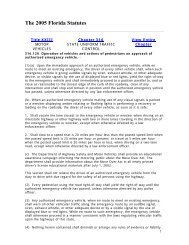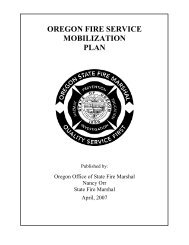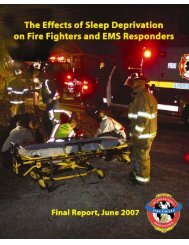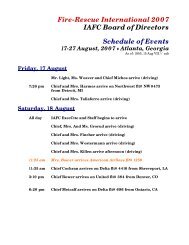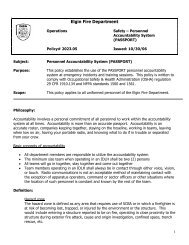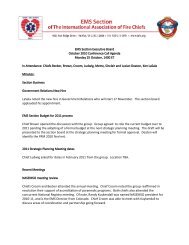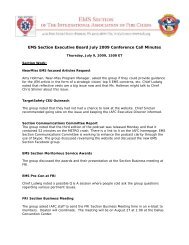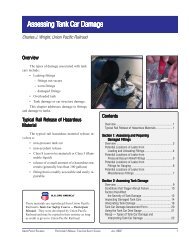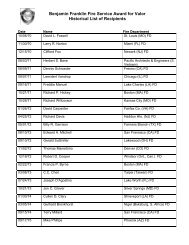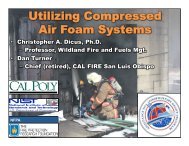January 2005.indd - International Association of Fire Chiefs
January 2005.indd - International Association of Fire Chiefs
January 2005.indd - International Association of Fire Chiefs
You also want an ePaper? Increase the reach of your titles
YUMPU automatically turns print PDFs into web optimized ePapers that Google loves.
<strong>Fire</strong> & emergency service news from the <strong>International</strong> <strong>Association</strong> <strong>of</strong> <strong>Fire</strong> <strong>Chiefs</strong><br />
I A F C<br />
<strong>January</strong> 15, 2005<br />
Volume 19 Number 1<br />
$3.50 per issue<br />
Memphis recruits pray before a training session the day after ‘Hell Night,’ when fellow recruit James Coleman<br />
collpased and went into a coma. Six others went to the hospital dehydtrated.<br />
‘Hell Night’ for recruits:<br />
Typical or an isolated incident?<br />
By Jule Gardner<br />
News accounts <strong>of</strong> a fire<br />
fighter training video<br />
out <strong>of</strong> Memphis, Tenn.,<br />
describe instructors taunting<br />
recruits.<br />
Recruits collapsed; seven<br />
became dehydrated and were<br />
treated at a local hospital.<br />
One, James Coleman,<br />
stayed there.<br />
Coleman, who was seen<br />
in the video picking up is<br />
his legs with his hands so he<br />
could keep moving, remained<br />
By John Tippett<br />
The first <strong>of</strong> three meetings<br />
<strong>of</strong> the National <strong>Fire</strong><br />
Fighter Near Miss Reporting<br />
Task Force took place at the<br />
Hyatt Regency, Reston, Va.,<br />
on Dec. 16 and 17, 2004. The<br />
task force, chaired by author<br />
Dennis Smith, well known<br />
for his commitment to fire<br />
fighter safety, was assembled<br />
to assist in implementing a<br />
national near miss reporting<br />
at press time in critical<br />
condition. He was unable to<br />
speak or breathe on his own,<br />
after slipping into a coma in<br />
October and slowly regaining<br />
consciousness.<br />
Much has been made in the<br />
fire service about “Hell Night,”<br />
what Memphis instructors<br />
and fire fighters call the<br />
department’s grueling set <strong>of</strong><br />
recruit training exercises.<br />
But is “Hell Night” typical<br />
<strong>of</strong> the culture <strong>of</strong> the fire service<br />
or is it an aberration?<br />
system for the nation’s fire<br />
service. The effort is funded<br />
by grants from the U. S. <strong>Fire</strong><br />
Administration and <strong>Fire</strong>man’s<br />
Fund Insurance.<br />
<strong>Fire</strong> fighter line <strong>of</strong> duty<br />
deaths and injuries continue to<br />
occur at the same rate as they<br />
did in 1977. This stagnated<br />
rate is troubling given the<br />
following:<br />
• Structure fires are down<br />
54 percent during the same<br />
Photo: The Commercial Appeal<br />
Really, it’s both, said IAFC’s<br />
Health & Safety Committee<br />
Chairman, Chief David<br />
Daniels <strong>of</strong> the Fulton County<br />
(Ga.) <strong>Fire</strong> Department.<br />
“You’ve got people on both<br />
sides <strong>of</strong> this,” he said.<br />
There’s a growing number<br />
<strong>of</strong> safety-minded <strong>of</strong>ficers and<br />
instructors who understand<br />
recruits are the most vulnerable<br />
<strong>of</strong> all fire fighters and need to be<br />
trained to protect themselves<br />
Let’s call training<br />
deaths what they<br />
really are: Fratricide<br />
The following letter written by<br />
Garry Briese, executive director<br />
<strong>of</strong> the IAFC, was originally<br />
printed in December’s <strong>Fire</strong><br />
Chief magazine. It is reprinted<br />
here with permission.<br />
Over the past several<br />
years, the fire service has<br />
had several fire fighter deaths<br />
and many serious injuries in<br />
training situations or even<br />
in basic fire fighter training<br />
courses. Why does any fire<br />
fighter need to die in training?<br />
What possible justification can<br />
be <strong>of</strong>fered for these deaths?<br />
In fact, according to both<br />
USFA and NFPA reports, about<br />
one in 10 fire fighter fatalities<br />
in 2003 were in a training<br />
context. What is unknown<br />
is how many <strong>of</strong> these deaths<br />
were <strong>of</strong> recruit fire fighters,<br />
perhaps the most vulnerable<br />
<strong>of</strong> all our fire fighters, since<br />
they are still learning the skills<br />
and knowledge necessary to<br />
survive.<br />
How ironic — recruits<br />
are trying to learn the skills<br />
and knowledge necessary to<br />
survive as a fire fighter and we<br />
kill them!<br />
We need to understand<br />
what training deaths are not:<br />
they are not accidents. These<br />
deaths and serious injuries<br />
occur in the most controllable<br />
environment in which we<br />
operate — a training situation.<br />
These deaths are the result <strong>of</strong><br />
carelessness, negligence, laxity,<br />
sloppiness, neglect, recklessness<br />
and imprudent or even stupid<br />
behavior on the part <strong>of</strong> those<br />
with the responsibility for<br />
the safety and welfare <strong>of</strong> the<br />
students: the training <strong>of</strong>ficers,<br />
the training chiefs and the fire<br />
department leadership.<br />
These are “trained and<br />
experienced leaders” who, at<br />
the very least, tolerate and,<br />
at the worst, condone and<br />
encourage the type <strong>of</strong> training<br />
which results in recruit or<br />
fire fighter deaths and serious<br />
injuries.<br />
We need to call these<br />
senseless deaths what they are:<br />
fratricide.<br />
Fratricide (frat*ri*cide),<br />
n., 1. the act <strong>of</strong> killing one’s<br />
brother. 2. one who murders<br />
or kills his own brother.<br />
The military used to call the<br />
actions <strong>of</strong> friendly forces that<br />
See ‘Hell Night’ : page 2 See Training: page 2<br />
Near Miss Task Force: Moving from concept to reality<br />
period.<br />
• Significant improvements<br />
have been made in fire fighter<br />
protective clothing.<br />
• And there’s been greater<br />
emphasis on fire fighter<br />
survival and training in the<br />
last 10 years.<br />
Sparked by an information<br />
exchange between the fire<br />
service, aviation industry and<br />
military more than four years<br />
ago, the development <strong>of</strong> a<br />
near miss reporting system<br />
for the fire service is thought<br />
to be necessary to reduce fire<br />
fighter line <strong>of</strong> duty deaths and<br />
injuries. One factor surfaced<br />
immediately. Parallels between<br />
operations in the cockpit, the<br />
military chain <strong>of</strong> command<br />
and the fire service make a<br />
near miss reporting system for<br />
the fire service a logical option<br />
to explore.<br />
Chief R. David Paulison,<br />
U.S. <strong>Fire</strong> Administrator,<br />
noted that reducing fire fighter<br />
deaths has been a difficult task<br />
because fire service culture<br />
glorifies death and hides<br />
mistakes. Sadly, most fire<br />
fighter fatalities are the result<br />
<strong>of</strong> a preventable occurrence.<br />
Even more notable is the fact<br />
that the resulting fatality or<br />
See Near Miss: page 4<br />
Route to: ❒ Chief ❒ Deputy Chief ❒ Assistant <strong>Chiefs</strong> ❒ Battalion <strong>Chiefs</strong>
Training deaths: fratricide<br />
from page 1<br />
result in DOD casualties “friendly<br />
fire.” Nothing could be further from<br />
the truth. But, at least these deaths<br />
are the result <strong>of</strong> a chaotic combat<br />
environment and <strong>of</strong>ten are due to<br />
human error under the duress <strong>of</strong><br />
combat. The fire service has no such<br />
“excuses” for our training deaths.<br />
The term “friendly fire” has been<br />
changed to reflect the seriousness<br />
with which the military now takes<br />
these casualties. “Fratricide” more<br />
accurately describes the seriousness<br />
that the military now ascribes to these<br />
preventable deaths.<br />
Deaths that occur in a military<br />
training environment result in<br />
immediate investigations, charges<br />
being filed under UCMJ, court<br />
marshal proceedings, convictions,<br />
fines, confinement in a military brig<br />
or jail, reduction in rank, elimination<br />
<strong>of</strong> all benefits (including retirement),<br />
termination <strong>of</strong> military careers and<br />
dishonorable discharges.<br />
Each time a fire fighter dies in a<br />
training environment, a full criminal<br />
investigation should immediately take<br />
place. These deaths are not accidents,<br />
these deaths are fratricide. People are<br />
directly and indirectly responsible for<br />
the death and all appropriate persons<br />
must be held personally accountable,<br />
including criminal, civil and career<br />
accountability.<br />
We owe that much to the training<br />
<strong>of</strong>ficers and fire chiefs who work hard<br />
to do it right.<br />
We owe this much to our recruits,<br />
our fire fighters and our families. ✠<br />
Garry Briese, CAE<br />
Executive Director, <strong>International</strong><br />
<strong>Association</strong> <strong>of</strong> <strong>Fire</strong> <strong>Chiefs</strong><br />
‘Hell Night’ discussed<br />
from page 1<br />
as well as their fellow fire fighters.<br />
“In the life <strong>of</strong> a fire fighter, recruits<br />
are like kindergartners. They’re not<br />
stupid, they just need to be taught<br />
what to do,” he said.<br />
“But what happened in Memphis is<br />
not new. And it’s not Memphis’ fault,”<br />
Chief Daniels said.<br />
“There’s a script out there and if all<br />
you’re doing is changing the actors,<br />
the next group is going to do the same<br />
thing,” he said.<br />
Many, if not most, <strong>of</strong> today’s<br />
instructors came up through a recruit<br />
regimen that would today be considered<br />
unfair, at best, and at worst: hazing. To<br />
be sure, they’re influenced by that, said<br />
both Daniels and Chief Gary Morris,<br />
past chair <strong>of</strong> the IAFC Health &<br />
Safety Committee and current chief<br />
<strong>of</strong> the Rural/Metro <strong>Fire</strong> Department<br />
for Maricopa and Pinal Counties, near<br />
Phoenix, Ariz.<br />
“Here’s my observation,” said Chief<br />
Morris, who also served as chief in<br />
Seattle, Wash., and retired after 30<br />
years with the Phoenix <strong>Fire</strong> Department<br />
as assistant chief. “People who are<br />
in chief <strong>of</strong>ficer positions typically<br />
have 20 to 30 years’ experience …<br />
and recruit training 30 years ago was<br />
very military, very in-your-face. The<br />
training <strong>of</strong>ficers had, at that time,<br />
complete authority to terminate an<br />
employee for any reason.”<br />
Today, that culture continues in<br />
many departments, both rural and<br />
metro, career and volunteer.<br />
And although there are standards —<br />
including NFPA 1582 (Comprehensive<br />
Occupational Medical Programs for<br />
<strong>Fire</strong> Departments), the IAFC/IAFF<br />
Health and Wellness Initiative and<br />
several NFPA standards for live fire<br />
training — those standards don’t cover<br />
a lot <strong>of</strong> what must to be covered when<br />
training new fire fighters, Chief<br />
Morris said.<br />
“The same focus that’s applied to<br />
safety at fireground operations needs to<br />
occur in the broader sense <strong>of</strong> training,”<br />
he said.<br />
And, in some places, that’s happening.<br />
“If you look around the country, you’re<br />
seeing stronger emphasis on curriculum<br />
and on teaching survival.<br />
“But we need to teach more recruits<br />
how to get themselves out <strong>of</strong> trouble<br />
when they get in it,” he said. For<br />
example, he said, there should be<br />
standards for awareness <strong>of</strong> SCBA air<br />
supply and how and when to declare<br />
a mayday.<br />
“The purpose <strong>of</strong> recruit training is<br />
not to weed out people,” Chief Morris<br />
said. “It’s to develop fire fighters.<br />
“You would never get away with<br />
people being treated like (recruits<br />
are) in the fire stations. There’d be<br />
lawsuits,” he said.<br />
“It’s a rite <strong>of</strong> passage that shouldn’t<br />
occur,” he added. “It opens the door<br />
to hazing.”<br />
Chief Daniels agreed and said<br />
that what happened in Memphis<br />
Continued: next column<br />
ANNOUNCEMENTS<br />
Scholarships available to <strong>Fire</strong>-Rescue Med<br />
The <strong>International</strong> <strong>Association</strong> <strong>of</strong> <strong>Fire</strong> <strong>Chiefs</strong>, in partnership with Jeep® brand<br />
— a member <strong>of</strong> the DaimlerChrysler Corporation — has embarked on a<br />
program to mentor future leaders in EMS.<br />
The IAFC will award scholarships to <strong>Fire</strong>-Rescue Med 2005 to be held in<br />
Las Vegas. Financial support for this scholarship program was provided by<br />
the DaimlerChrysler Fund to the IAFC through the Jeep Everyday Heroes<br />
Porgram. The purpose <strong>of</strong> this program is to further the education <strong>of</strong> future<br />
leaders in fire-based EMS. To that end, this partnership focuses on developing<br />
the human resources necessary to meet the EMS challenges <strong>of</strong> the future.<br />
Scholarships will include full registration (pre-conference included), air<br />
travel, and lodging in Las Vegas. This will include pre-conference registration<br />
for Staying Alive: EMS Safety conducted by Richard Patrick, Director <strong>of</strong> EMS<br />
Programs and Emergency Services Initiatives at VFIS.<br />
Selection will be done by a special committee <strong>of</strong> the EMS Section <strong>of</strong> IAFC<br />
with emphasis given to first-time attendees and those <strong>of</strong>ficers with primary<br />
responsibility for EMS. Applicants must submit a resume and an essay.<br />
Instructions will be available on the IAFC Web site, www.iafc.org. Deadline<br />
for applications is February 14, 2005. Award notifications will be made on<br />
March 1, 2005.<br />
Command course set in Maryland<br />
The 2005 National <strong>Fire</strong> Service Staff and Command Course, presented in<br />
cooperation with the IAFC by the Maryland <strong>Fire</strong> & Rescue Institute at the<br />
University <strong>of</strong> Maryland, will be March 9 to 16 in Ocean City, Md.<br />
The course, a high-intensity and concentrated program, is designed to help<br />
<strong>of</strong>ficers with modern concepts <strong>of</strong> management, technical skills and pr<strong>of</strong>essional<br />
knowledge.<br />
It’s open to all personnel above the company <strong>of</strong>ficer level and involves networking<br />
and interactive exercises involving several relevant subjects, including: applying<br />
NIMS to a major incident, grant writing, grievance management, dealing with<br />
elected <strong>of</strong>ficials, and various case studies.<br />
The course will be held at the Clarion Resort Fountainbleau Hotel in Ocean<br />
City. For more information or to register, call MFRI at 301-226-9962 or<br />
800-ASK MFRI or visit www.mfri.org.<br />
Laidlaw sells AMR<br />
On Dec. 6, Laidlaw <strong>International</strong>, Inc. announced it will sell American Medical<br />
Response, the largest private provider <strong>of</strong> ambulance transport services in the<br />
United States, and its other medical company, EmCare, to Onex Partners LP,<br />
an affiliate <strong>of</strong> Onex Corp., for $820 million. Net cash proceeds to Laidlaw are<br />
expected to be approximately $775 million after debt assumed by the buyer and<br />
payment <strong>of</strong> transaction costs. Completion <strong>of</strong> the sale is anticipated by the end <strong>of</strong><br />
March, 2005.<br />
Onex Partners LP, a $2.2 billion private equity fund established by Onex Corp.,<br />
is headquartered in New York. Onex Corp. is one <strong>of</strong> Canada’s largest companies<br />
with global operations in service, manufacturing and technology industries. It<br />
has annual consolidated revenues <strong>of</strong> approximately $16 billion.<br />
‘Hell Night’ ... continued<br />
– or anywhere else – is not an excuse<br />
for people who know better to point<br />
fingers.<br />
“This is just the latest incident.<br />
Yes, it’s deplorable. It’s bad; it’s all <strong>of</strong><br />
those things,” he said. “But it’s not<br />
something that we should criticize<br />
then walk away.<br />
“The worst thing we can do is turn<br />
on each other when we should be<br />
turning to one another.<br />
“This is not just a problem in<br />
Memphis,” he said. “This is a problem<br />
for all <strong>of</strong> us, for all fire chiefs.” ✠<br />
For an in-depth look at creating a<br />
safe training culture, check out Chief<br />
Gary Morris’ feature in the February<br />
<strong>Fire</strong> Chief.<br />
Jule Gardner is IAFC’s<br />
communications manager and<br />
editor <strong>of</strong> On Scene.<br />
2 IAFC On Scene/<strong>January</strong> 15, 2005
Shipments <strong>of</strong><br />
hazardous<br />
materials by<br />
motor carriers<br />
are considered<br />
highly vulnerable to catastrophic<br />
terrorism. Each day in the United<br />
States, there are more than 800,000<br />
shipments <strong>of</strong> hazardous materials. On<br />
a daily basis, there are about 300,000<br />
movements <strong>of</strong> hazmats according to the<br />
U.S. Department <strong>of</strong> Transportation.<br />
The local emergency responders<br />
will always be the first to confront a<br />
hazmat emergency, whether caused<br />
by an accident or terrorist act, and<br />
will play the central role in managing<br />
its immediate consequences,<br />
acknowledged a 2003 report issued<br />
by the Independent Task Force on<br />
Emergency Responders, sponsored by<br />
the Council on Foreign Relations.<br />
“The efforts <strong>of</strong> emergency responders<br />
in the first minutes and hours<br />
following an attack will be critical to<br />
saving lives, reestablishing order and<br />
preventing mass panic,” noted the<br />
report, which was entitled “Emergency<br />
Responders: Drastically Underfunded,<br />
Dangerously Unprepared.” It<br />
called for increased funding and<br />
underscored the importance <strong>of</strong><br />
interoperable communications systems<br />
for emergency responders across the<br />
country so that those on the front lines<br />
can communicate with each other<br />
while at the scene <strong>of</strong> an attack.<br />
Staying Informed<br />
Advanced communication and<br />
information sharing is vital for<br />
improving the response to hazmat<br />
incidents, both intentional and<br />
unintentional.<br />
To assist local emergency<br />
responders, the U.S. Department <strong>of</strong><br />
Transportation, in cooperation with<br />
several private sector organizations,<br />
has been evaluating new technology to<br />
help improve the safety and security <strong>of</strong><br />
hazardous materials during transport.<br />
Critical Information<br />
Improving hazmat incident response<br />
During some field operations tests in<br />
2004, nine commercial hazmat carriers<br />
involving 100 trucks, multiple shippers,<br />
and law enforcement and emergency<br />
response agencies from New York,<br />
Illinois, Texas and California tested<br />
a system called E2RMS (Emergency<br />
Response Management System).<br />
The Spill Center, a Massachusetts<br />
based company that helps hazmat<br />
carriers manage hazmat spills, was one<br />
<strong>of</strong> the prime developers <strong>of</strong> E2RMS<br />
— a system is designed to provide<br />
a local emergency operation center<br />
with immediate and validated hazmat<br />
incident information from carriers<br />
and shippers within minutes <strong>of</strong> an<br />
occurrence <strong>of</strong> a hazmat incident.<br />
According to Tom Moses <strong>of</strong> the<br />
Spill Center, the project was designed<br />
to provide high-level analysis <strong>of</strong> safety<br />
and security risks in the transportation<br />
<strong>of</strong> hazmat by continuously monitoring<br />
data streaming from truck tracking<br />
systems, on-board computers and<br />
other equipment. The system uses<br />
“intelligent agents,” which compare<br />
the streaming data with predetermined<br />
triggers that will identify an emergency<br />
or a developing incident that requires<br />
an immediate response.<br />
When patterns associated with<br />
increased risk are identified, alerts are<br />
automatically sent to law enforcement,<br />
response agencies, transporters,<br />
shippers and other registered users.<br />
Physical security devices and sensors,<br />
as well as radio frequency identification<br />
(RFID)-tagged containers can also be<br />
integrated into the system.<br />
Hijacking Scenario<br />
Certain combinations <strong>of</strong> incoming<br />
data might indicate a truck has been<br />
hijacked. In one scenario, a truck’s onboard<br />
computer sends data indicating<br />
that the vehicle, carrying a PIH material<br />
(poisonous by inhalation), is speeding<br />
on US-71 in Bentonville, Ark., in<br />
the vicinity <strong>of</strong> a populated stadium<br />
or a school. This specific pattern<br />
— a speeding truck, carrying highly<br />
toxic material, in a populated area —<br />
represents a potential threat. In that<br />
case, an alert message would be sent to<br />
a list <strong>of</strong> appropriate authorities. Even if<br />
the driver were incapacitated, the alert<br />
message would be transmitted.<br />
E2RMS technology showed its ability<br />
to provide real-time information from<br />
the carrier’s manifest data base about<br />
the hazmat cargo; the vehicle’s exact<br />
location from its GPS locater, and<br />
the nature <strong>of</strong> the incident, enabling<br />
emergency responders to arrive at the<br />
scene faster and better prepared to<br />
handle the incident.<br />
During the field test, actual<br />
information from a number <strong>of</strong><br />
different participants was analyzed<br />
by an intelligence agent according to<br />
customized rules, searching for data<br />
patterns or specific criteria defined by<br />
users. As those patterns were detected<br />
and criteria met, the system sent one<br />
or more messages, according to a userspecified<br />
distribution list.<br />
Alert notifications were related to<br />
situations involving unauthorized<br />
drivers, <strong>of</strong>f-route conditions and panicmessage<br />
data received from the trucks.<br />
Color-coded red, yellow and green —<br />
based on the perceived threat — the<br />
alerts were delivered in the individual<br />
user’s choice <strong>of</strong> e-mail, fax, page, phone<br />
text messages and voice notification.<br />
Customize to Needs<br />
The results were real-time alerts based<br />
on monitoring <strong>of</strong> hazmat shipment<br />
information, increased load security<br />
and enhanced law enforcement actions<br />
and incident responses in selected test<br />
areas. It also allowed recipients <strong>of</strong> the<br />
information to create and manage<br />
rules via the Internet that specified<br />
which conditions triggered alerts and<br />
sent notifications. According to Moses,<br />
the intelligence agents can be modified<br />
by police, fire fighters, fleets and other<br />
participating organizations, according<br />
to the type <strong>of</strong> information and criteria<br />
that each specified. For example,<br />
if a special event is taking place in a<br />
community, the alert criteria can be<br />
adjusted for the duration <strong>of</strong> the event.<br />
The use <strong>of</strong> GIS, GPS and other<br />
telematic devices by law enforcement,<br />
fire and rescue services, shippers<br />
and transporters, and many other<br />
segments <strong>of</strong> society are becoming<br />
very widespread. Rather than creating<br />
something separate, the E2RMS<br />
can be incorporated into the existing<br />
platform.<br />
Using Existing Data and<br />
Information<br />
Sign up now to join IAFC members in Germany<br />
Intershutz, the global fire and rescue<br />
event that happens once every five<br />
years, will take place June, 2005, in<br />
Hanover, Germany.<br />
More than 130,000 public safety<br />
personnel from nearly 40 countries are<br />
expected to attend, as are more than<br />
1,000 companies and exhibitors in the<br />
areas <strong>of</strong> rescue, fire prevention, disaster<br />
relief, safety and security.<br />
Sign up now to join. A travel<br />
package available to members includes<br />
roundtrip airfare, four-star hotel,<br />
admission to the fairgrounds, and<br />
much more. Members who sign up<br />
will depart the U.S. on June 3, 2005,<br />
There are new hazmat information<br />
systems being proposed everyday that<br />
can deliver hazmat information fast.<br />
The problem: The systems usually<br />
have no information to deliver — it<br />
is either so generic that it has no value<br />
or belongs to someone else who may<br />
not want to dump it into a database<br />
for security, business or proprietary<br />
reasons.<br />
The E2RMS approach uses electronic<br />
information already in place and uses<br />
the Internet and other communication<br />
channels to provide incident, threat<br />
and vulnerability information to public<br />
safety agencies when it is needed.<br />
More importantly, it can integrate<br />
output from any telematic device,<br />
irrespective <strong>of</strong> type, manufacturer<br />
or proprietary s<strong>of</strong>tware, he says, and<br />
deliver meaningful information,<br />
events messages, and alert notification<br />
to users based on what they need and<br />
want.<br />
Technology will continue to enhance<br />
the ability for hazardous materials<br />
responders to access up-to-the-minute<br />
information. By staying abreast <strong>of</strong><br />
new information, responders will<br />
continue to increase their efficiency,<br />
effectiveness and safety. ✠<br />
This article is sponsored through a<br />
cooperative agreement between the U.S.<br />
<strong>Fire</strong> Administration and the IAFC.<br />
and return June 12, 2005. There is<br />
also an optional three-day package<br />
tour for Berlin to Warsaw.<br />
For more information, contact<br />
Marie Coleman at:<br />
mariekcole@aol.com, call (916) 682-<br />
2537 or fax (916) 689-4998. ✠<br />
IAFC On Scene/<strong>January</strong> 15, 2005<br />
3
IAFC applauds 9-11 legislation signed by President<br />
President Bush signed the Intelligence<br />
Reform and Terrorism Prevention Act<br />
<strong>of</strong> 2004 (S. 2845) into law on Dec. 17,<br />
2004.<br />
In a press release, the IAFC applauded<br />
Congress and the administration<br />
on “this groundbreaking and highly<br />
important piece <strong>of</strong> homeland security<br />
from page 1<br />
injury is the end result <strong>of</strong> a string <strong>of</strong><br />
seemingly unrelated incidents. The<br />
tragedy and personal loss are <strong>of</strong>ten<br />
overshadowed by the ceremony <strong>of</strong> the<br />
line <strong>of</strong> duty death funeral.<br />
Chief Paulison stated that the flag<br />
at the National Fallen <strong>Fire</strong>fighters’<br />
Memorial hangs at half-staff every third<br />
day. After the honor and ceremony <strong>of</strong><br />
the funeral, lives are still shattered, the<br />
loss and pain are permanent. We have<br />
to redouble our efforts to keep the entire<br />
fire service family from experiencing<br />
the anguish and eternal loss <strong>of</strong> a loved<br />
one. The U. S. <strong>Fire</strong> Administration is<br />
enthusiastically supporting the project<br />
based on the documented success <strong>of</strong><br />
the aviation industry experience.<br />
Also at the meeting, Daryl Siry, Vice<br />
legislation,” said IAFC President Chief<br />
Bob DiPoli.<br />
The Intelligence Reform and<br />
Terrorism Prevention Act <strong>of</strong> 2004<br />
includes a number <strong>of</strong> measures that are<br />
important to America’s fire service.<br />
“This bill codifies a number <strong>of</strong> very<br />
important emergency preparedness<br />
President, <strong>Fire</strong>man’s Fund Insurance<br />
Company and Executive Director <strong>of</strong><br />
the <strong>Fire</strong>man’s Fund Heritage Program,<br />
informed the task force that <strong>Fire</strong>man’s<br />
Fund’s interest in the project stemmed<br />
from its 100-year-plus association with<br />
the fire service. The Heritage Program<br />
issues grants to organizations interested<br />
in promoting fire fighter safety.<br />
From the aviation industry, Linda<br />
Connell, Director <strong>of</strong> the NASA<br />
Airline Safety Reporting System,<br />
told the group that the keys to the<br />
aviation system’s documented success<br />
lie in its confidentiality, non-punitive<br />
posture, buy-in from all stakeholders<br />
(i.e., Air Line Pilots <strong>Association</strong>,<br />
Federal Aviation Administration),<br />
and feedback from the stakeholders<br />
validating the program success. The<br />
and response initiatives that will help<br />
fire fighters do their jobs,” said Chief<br />
Michael Freeman <strong>of</strong> the Los Angeles<br />
County <strong>Fire</strong> Department, chairman <strong>of</strong><br />
the IAFC’s Terrorism and Homeland<br />
Security Committee.<br />
The IAFC has developed a document<br />
for its members that details items in<br />
aviation industry has accumulated<br />
28 years <strong>of</strong> data in its near miss<br />
reporting system.<br />
Also at the meeting: The “Father<br />
<strong>of</strong> Human Factors,” Dr. Robert<br />
Helmreich (University <strong>of</strong> Texas). He<br />
told the task force that his research into<br />
errors and reporting in the aviation<br />
and medical industry support that the<br />
system will work in the fire service.<br />
Dr. Helmreich noted that 70 percent<br />
<strong>of</strong> all commercial pilots have filed<br />
a near miss report and 97 percent <strong>of</strong><br />
the events reported are not known by<br />
any other source. Since fire fighters are<br />
generally driven by a desire to help and<br />
save lives, he believes that near miss<br />
reporting for the fire service will be<br />
successful as long as fire fighters realize<br />
that the lives they are saving are those<br />
the bill and provides an analysis <strong>of</strong><br />
how they will impact the fire service.<br />
Download the IAFC’s analysis <strong>of</strong> the<br />
emergency preparedness and response<br />
provisions <strong>of</strong> the Intelligence Reform<br />
and Terrorism Prevention Act:<br />
@ www.iafc.org/government/index.<br />
asp#homeland.<br />
Near Miss: Task force takes project from concept to reality<br />
<strong>of</strong> their fellow fire fighters.<br />
The task force has a series <strong>of</strong> meetings<br />
planned to move the project from the<br />
concept stage to full use delivery by<br />
October 2005. The aggressive timeline<br />
will involve an action plan that includes<br />
focus group meetings across the United<br />
States, database development and<br />
testing based on focus group input,<br />
soliciting fire departments to test the<br />
system and a roll out at IAFC’s <strong>Fire</strong>-<br />
Rescue <strong>International</strong> Conference in<br />
Denver, Colo., August 2005. ✠<br />
John Tippett is project manager<br />
for the IAFC and a battalion chief<br />
with the Montgomery County<br />
(Md.) Division <strong>of</strong> <strong>Fire</strong> and Rescue<br />
Services.<br />
4 IAFC On Scene/<strong>January</strong> 15, 2005
CONFINED SPACE<br />
RESCUE EQUPMENT<br />
Liquidation <strong>of</strong> complete team<br />
equipment including ropes, pulleys,<br />
webbing, harnesses, helmets,<br />
communications, carbon cylinders,<br />
tripod and much more. Call <strong>Fire</strong><br />
Marshal Andrew Gurka at (313) 791-<br />
3657 for complete list.<br />
IAFC On Scene is read by 12,000<br />
highly qualifi ed fi re chiefs and<br />
company <strong>of</strong>fi cers. To advertise,<br />
please call (703) 273-9815 ext. 307<br />
or email On Scene Editor Jule Gardner<br />
at jgardner@iafc.org. Ads must be<br />
received one month prior to publication.<br />
I A F C<br />
Volume 19, Number 1<br />
IAFC Executive Director<br />
Garry L. Briese, CAE<br />
Communications Director<br />
Jennifer A. Ashley<br />
Editor/Communications Manager<br />
Jule Gardner<br />
Graphic Designer<br />
Nhu Mai Le<br />
CLASSIFIEDS<br />
FIRE CHIEF<br />
The City <strong>of</strong> Leavenworth, Kansas (pop.<br />
36,000) is seeking an individual with<br />
strong leadership skills for <strong>Fire</strong> Chief.<br />
The ideal candidate must have high<br />
integrity, excellent interpersonal and<br />
communication skills, proven history <strong>of</strong><br />
fire protection management experience<br />
and proven history <strong>of</strong> developing<br />
positive relationships with employees,<br />
colleagues and the community.<br />
For complete job description and<br />
minimum requirements, please visit<br />
the City’s website at: www.lvks.org.<br />
Salary Range: $61,202 - $91,804.<br />
The City has an outstanding benefit<br />
package, including medical & dental<br />
insurance, department vehicle and<br />
KP&F. Residency requirement. Please<br />
send resume to: City <strong>of</strong> Leavenworth,<br />
Attn: HR, 100 N. 5th Street,<br />
Leavenworth, Kansas 66048; or send<br />
as a Micros<strong>of</strong>t Word attachment to<br />
dweaverling@firstcity.org by <strong>January</strong><br />
19, 2005. The City <strong>of</strong> Leavenworth is<br />
an EEO/ADA employer.<br />
HQ Review<br />
Happenings and events<br />
in and around IAFC<br />
The IAFC’s Eastern Division leadership met in November for the fi rst time with representatives<br />
<strong>of</strong> the fi ve State <strong>Chiefs</strong> Organizations that make up the Eastern Division: Delaware, Maryland,<br />
New Jersey, New York and Pennsylvania.<br />
On Dec. 3 and 4, the EMS Section hosted a meeting to discuss the association’s<br />
comments on the draft national model EMS Scope <strong>of</strong> Practice published by the National<br />
Highway Safety Administration. Among<br />
those in attendance: Dan Manz,<br />
Principal Investigator, pictured at left.<br />
The EMS Section asked interested fi re<br />
departments to review the document<br />
and submit comments to the IAFC for<br />
consideration. The Scope <strong>of</strong> Practice Model<br />
is the second stage <strong>of</strong> a three-stage process<br />
led by NHTSA to revise and update the EMS<br />
curriculum. The comments are being internally<br />
reviewed by the IAFC and will be published.<br />
IAFC Board <strong>of</strong> Directors<br />
Bob DiPoli, President<br />
Bill Killen, First Vice President<br />
James Harmes, Second Vice President<br />
Ernie Mitchell, Immediate Past President<br />
Julian Taliaferro, Treasurer<br />
Larry J. Grorud, Great Lakes Division<br />
Don Warden, Canadian Division<br />
William Walton Jr., Eastern Division<br />
Jack J. Krakeel, EMS Section<br />
Luther L. Fincher Jr., Metro <strong>Chiefs</strong> Section<br />
Steven P. Westermann, Missouri Valley Division<br />
Roger Bradley, New England Division<br />
Jack K. McElfish, Southeastern Division<br />
Jerry S. Bower, Southwestern Division<br />
Fred Windisch, VCOS<br />
Timothy Riley, Western Division<br />
IAFC On Scene (ISSN 0893-3936) is an<br />
<strong>of</strong>ficial publication <strong>of</strong> the <strong>International</strong> <strong>Association</strong> <strong>of</strong><br />
<strong>Fire</strong> <strong>Chiefs</strong>. Our goal for this newsletter is to provide<br />
fire and emergency services managers with information<br />
to help them make timely and appropriate decisions.<br />
The opinions expressed in the newsletter are<br />
those <strong>of</strong> the individual authors and do not necessarily<br />
represent the <strong>of</strong>ficial position <strong>of</strong> the association.<br />
The <strong>International</strong> <strong>Association</strong> <strong>of</strong> <strong>Fire</strong> <strong>Chiefs</strong>,<br />
organized in 1873, is dedicated to the advancement<br />
<strong>of</strong> the fire service. Its mission statement: Provide<br />
leadership to career and volunteer chiefs, chief<br />
fire <strong>of</strong>ficers and managers <strong>of</strong> emergency service<br />
organizations throughout the international community<br />
through vision, information, education, services and<br />
representation to enhance their pr<strong>of</strong>essionalism and<br />
capabilities.<br />
Questions about material in this issue should be<br />
directed to the editor at: 703/273-9815 ext. 307. The<br />
IAFC main number is 703/273-0911; fax 703/273-<br />
9363.<br />
Unless otherwise noted, all material in IAFC<br />
On Scene is copyright 2005 by the <strong>International</strong><br />
<strong>Association</strong> <strong>of</strong> <strong>Fire</strong> <strong>Chiefs</strong>.<br />
On Dec. 14, IAFC Headquarters hosted<br />
a meeting <strong>of</strong> the Virginia <strong>Fire</strong> <strong>Chiefs</strong><br />
<strong>Association</strong>, Inc. Pictured, from left, are Bill<br />
Smith, executive director <strong>of</strong> VA <strong>Fire</strong> <strong>Chiefs</strong>;<br />
Mary Beth Michos, Prince William County<br />
<strong>Fire</strong> and Rescue chief; and Willie Howlett,<br />
1st vice president <strong>of</strong> VA <strong>Fire</strong> <strong>Chiefs</strong>.<br />
Keep in touch with IAFC<br />
Many IAFC members are<br />
not receiving <strong>of</strong>ficial IAFC<br />
correspondence. It’s getting lost<br />
in other fire department mail.<br />
Make sure you receive every piece<br />
<strong>of</strong> information by sending us<br />
your home address. Log into the<br />
members-only section <strong>of</strong> the IAFC<br />
Web site at www.iafc.org and click<br />
“update pr<strong>of</strong>ile” on the member<br />
welcome page to add your home<br />
address to your contact information.<br />
Or, e-mail membership@iafc.org or<br />
call 703/273-0911 and ask to speak<br />
with someone in the member services<br />
department. ✠<br />
IAFC On Scene/<strong>January</strong> 15, 2005<br />
5
IAFC Pr<strong>of</strong>ile<br />
Jose Torres: Washington Flyer driver is ‘always there’<br />
By Jule Gardner<br />
Jose Torres figures he’s driven about<br />
1.7 million miles in his cab without<br />
an accident.<br />
It’s without doubt an impressive<br />
safe driving record. But it’s only one<br />
reason Torres has become the preferred<br />
“Washington Flyer” taxi service driver<br />
<strong>of</strong> the IAFC.<br />
Torres’ association with this<br />
association started about 14 years ago,<br />
when he picked up Executive Director<br />
Garry Briese as a customer. Briese<br />
noticed Torres’ courteousness and his<br />
dependability and has come to rely on<br />
it for himself, IAFC members and the<br />
IAFC staff.<br />
“<br />
I wait for the<br />
customer; I don’t like<br />
the customer to wait<br />
for me.<br />
”<br />
–Jose Torres<br />
“Jose is the most reliable and<br />
pleasant person,” Briese said. “We have<br />
enjoyed a long relationship and he’s<br />
always there when we need him. I have<br />
tremendous respect for his driving and<br />
safety record!”<br />
“That was one <strong>of</strong> the best things I<br />
did,” Torres said about gaining Briese<br />
as a “regular.” “Now I think I have<br />
taken care <strong>of</strong> at least 10 <strong>of</strong> the last<br />
presidents (<strong>of</strong> IAFC).”<br />
Washington Flyer drives people to<br />
and from the airports surrounding<br />
Washington, D.C. – Dulles, Reagan<br />
The Emergency Management and<br />
Response-Information Sharing and<br />
Analysis Center (EMR-ISAC), in<br />
development since 1998, became even<br />
more relevant after Sept. 11, 2001.<br />
Thousands <strong>of</strong> fire chiefs and<br />
departments have signed on, provided<br />
and received sensitive information.<br />
Now, the center’s level <strong>of</strong><br />
information-sharing has become even<br />
more relevant and specific.<br />
As <strong>of</strong> Nov. 1, the center can<br />
regionally target information. The<br />
newest development came out <strong>of</strong><br />
EMR-ISAC’s efforts to improve its<br />
successful “Infogram” and sensitive<br />
Critical Infrastructure Protection, or<br />
CIP, information-sharing programs,<br />
National and Baltimore/Washington<br />
<strong>International</strong> – although Torres will<br />
take his regulars anywhere they want<br />
to go.<br />
And he will get there early, without<br />
charging for waiting time. “I wait for<br />
the customer,” he said. “I don’t like the<br />
customer to wait for me.”<br />
The 2003 Lincoln Town Car he<br />
currently drives is his fourth car. He<br />
puts about 500,000 miles on each car<br />
before trading it in, which is how he<br />
estimated his mileage.<br />
He started driving with Washington<br />
Flyer after moving to the capital region<br />
from New York City, where he ran a<br />
parking garage. He came to the U.S.<br />
from Ecuador in 1970 and has a home<br />
in northern Virginia he shares with his<br />
wife and four children.<br />
Two have graduated from college<br />
and two are still in college. “Education<br />
is a priority for me,” he said. “It’s the<br />
only way to have a better life. … That’s<br />
why I work seven days a week. It’s<br />
expensive!”<br />
Regarding his safe driving record,<br />
Torres chalks some <strong>of</strong> it up to luck. But<br />
he’s careful, too, he said.<br />
He doesn’t speed unless there’s an<br />
emergency. “What’s the point <strong>of</strong> going<br />
80 miles per hour and get to the airport<br />
two minutes earlier?” he asked.<br />
He leaves early, checks his mirrors<br />
<strong>of</strong>ten and he does not get easily<br />
frustrated by things he cannot change,<br />
namely traffic.<br />
“You have to deal with the traffic,”<br />
he said. “There is no other way. If I<br />
get angry with traffic or with another<br />
driver, I could get in an accident.”<br />
“Sometimes,” he said, “if a customer<br />
available to chiefs and <strong>of</strong>ficers in<br />
emergency services.<br />
Located at the National Emergency<br />
Training Center, a secure facility, the<br />
EMR-ISAC can provide round-theclock<br />
operations and CIP information<br />
for first responders during periods <strong>of</strong><br />
national crisis.<br />
Nearly 17,000 emergency responders<br />
receive CIP information from the<br />
EMR-ISAC, and the numbers continue<br />
to rise on a daily basis.<br />
Using an Internet-based secure portal,<br />
accessed through www.DisasterHelp.<br />
gov, the center disseminates<br />
Department <strong>of</strong> Homeland Security<br />
Sensitive CIP Information, labeled<br />
“For Official Use Only,” to key federal,<br />
Jose Torres, the IAFC’s longtime taxi driver, talks to a passenger in the backseat while<br />
driving in downtown Washington. Torres estimates his safe-driving record at 1.7 million<br />
miles.<br />
IAFC President<br />
Chief Bob<br />
DiPoli, left, is<br />
recently picked<br />
up at Regan<br />
National Airport<br />
by ‘Washington<br />
Flyer’ Jose Torres,<br />
who has driven<br />
at least 10 <strong>of</strong> the<br />
past presidents <strong>of</strong><br />
IAFC.<br />
wants to take a different way, I say OK.<br />
I will go whatever way the customer<br />
wants, even if there will be more<br />
traffic. If not, I pick what I think will<br />
be the best and say to the customer:<br />
‘I’m going to go this way. I hope you<br />
like it.’”<br />
Torres hopes to cut back some hours<br />
and retire within five years. But it’s not<br />
because he is unhappy.<br />
state, tribal and local emergency service<br />
leaders (including fire, EMS and police<br />
department chief and deputy chief<br />
<strong>of</strong>ficers; senior emergency managers;<br />
and fire marshals).<br />
Relevant examples <strong>of</strong> recently<br />
disseminated CIP information include<br />
“Potential Terrorist Use <strong>of</strong> Emergency<br />
Vehicles” (10/14/04) and “How<br />
Terrorists Might Exploit a Natural<br />
Disaster” (9/15/04).<br />
The sensitive CIP informationsharing<br />
initiative supports effective<br />
preparedness and mitigation activities<br />
by emergency departments. It<br />
provides a degree <strong>of</strong> knowledge that<br />
agency leaders must have to enhance<br />
organizational survivability, continuity<br />
“I am fortunate,” he said. “I have<br />
flexibility. … I could not have an<br />
inside job.<br />
“And I have beautiful customers,”<br />
Torres said. “They are wonderful<br />
people to work with.” ✠<br />
Jule Gardner is IAFC’s<br />
communications manager and<br />
editor <strong>of</strong> On Scene.<br />
Sign up now: Sensitive information sharing targets specific regions<br />
<strong>of</strong> operations, and mission success.<br />
Several chief <strong>of</strong>ficer recipients <strong>of</strong> this<br />
no-cost sharing endeavor have said it<br />
gives them the time and information<br />
necessary to appropriately adjust<br />
emergency plans and operations,<br />
and to protect their internal critical<br />
infrastructures against terrorism.<br />
To receive sensitive CIP<br />
information, you must be willing<br />
to provide your full name, duty<br />
position or title, electronic address,<br />
organization/agency name and<br />
physical address.<br />
@ For more information on how<br />
to sign up to receive this information,<br />
visit: http://disasterhelp.gov/usfacip.<br />
html.<br />
6 IAFC On Scene/<strong>January</strong> 15, 2005
By Chief John M. Buckman III<br />
German Township Volunteer<br />
<strong>Fire</strong> Department<br />
VCOS Chairman: 1994-1997<br />
When I became chairman, I<br />
envisioned an organization<br />
that would provide something to chiefs<br />
<strong>of</strong> volunteer departments to help them<br />
become better leaders. One <strong>of</strong> our<br />
first projects was to research volunteer<br />
leadership training throughout the<br />
country. We found very few courses<br />
designed for volunteer leadership with<br />
volunteer subjects. That’s when the<br />
committee developed the leadership<br />
course, still delivered today as an<br />
updated version <strong>of</strong> the original.<br />
We also spent considerable time<br />
at board meetings to see how the<br />
organization worked and quickly<br />
realized that if we were to be effective,<br />
we needed to establish ourselves<br />
as a section. We were successful in<br />
motivating the IAFC members at the<br />
St. Louis <strong>Fire</strong>-Rescue <strong>International</strong> to<br />
sign the petitions and attend the very<br />
first meeting. That meeting room in<br />
St. Louis overflowed. The crowd was<br />
loud and boisterous and I am forever<br />
indebted to Chief Mike Chiaramonte,<br />
who was serving as a board member,<br />
for coming forward to run the first<br />
meeting.<br />
I really enjoyed my tenure as<br />
chairman and still look at the VCOS<br />
board and <strong>of</strong>ficers with a tremendous<br />
amount <strong>of</strong> pride in what they are doing<br />
to help the volunteer and combination<br />
leadership. ✠<br />
Ten years <strong>of</strong> VCOS: Reflections on IAFC’s<br />
Volunteer/Combination Officers Section<br />
By Chief Fred Windisch<br />
Ponderosa Volunteer <strong>Fire</strong><br />
Department<br />
VCOS Chairman: 1997-1999<br />
During the “formative” years <strong>of</strong><br />
my chairmanship, we had a lot<br />
<strong>of</strong> focus on bylaws, organizational<br />
procedures and our attempts to<br />
“nationalize” the VCOS. (We’re still<br />
working on that…)<br />
I remember the solid support given<br />
by the IAFC Board <strong>of</strong> Directors and<br />
IAFC staff. We understood we were<br />
still new, but the constant support<br />
helped guide us through the hard<br />
times. I also remember discussing with<br />
Chief Buckman two dreams. The<br />
first one was the development <strong>of</strong> the<br />
Leadership Course and the second one<br />
was the symposium.<br />
The Leadership Course is truly<br />
more than a dream; it’s a very<br />
successful effort to educate our peers.<br />
That dream became a reality when a<br />
simple question was posed to Pierce<br />
Manufacturing: What can you do to<br />
help educate the volunteer fire service?<br />
The rest is history.<br />
The Symposium started as a “what<br />
if” question. We started with 105<br />
attendees; six years later we had 350.<br />
We’ve broken even or lost a little in<br />
some years, and we had some positive<br />
revenue to do more VCOS projects<br />
in other years. I believe symposium<br />
attendees will attest to the success.<br />
VCOS is truly an organization <strong>of</strong><br />
dynamics. The commitment <strong>of</strong> our<br />
past, present and future board members,<br />
along with a strong membership base,<br />
will certainly benefit our nation’s<br />
volunteer and combination fire<br />
service. ✠<br />
By Deputy Chief Larry Curl<br />
Hilmon <strong>Fire</strong>fighters, Inc.<br />
VCOS Chairman: 2002-present<br />
Just over two years ago when I stepped into this position, my first reaction was<br />
fear. I was truly fearful <strong>of</strong> not being able to lead such a terrific organization as<br />
well as my predecessors had done.<br />
Since taking <strong>of</strong>fice, I have been assisted by an executive committee made up <strong>of</strong><br />
Robert Bettenhausen, Fred Windisch and Tim Wall, and we work together as a<br />
real partnership in the managing <strong>of</strong> VCOS.<br />
We’ve just completed our tenth year, and what a success story that has been.<br />
We have had the opportunity to lay a strong foundation upon which we continue<br />
to build. We have had some <strong>of</strong> the very finest fire service leadership join our<br />
board and assist in the overall development and management <strong>of</strong> VCOS. We<br />
have strengthened the 21st Century Leadership program that was started just<br />
a few years ago and remain thankful to our sponsor <strong>of</strong> this program, Pierce<br />
Manufacturing. We’ve just completed our sixth VCOS Symposium and, while<br />
getting started was a bit shaky, we have overcome that and are now on the road<br />
to providing all our attendees with one <strong>of</strong> the finest educational opportunities<br />
available. We have established a strategic plan (just over two years old) that will<br />
soon be going into a revision mode, and we have created a list <strong>of</strong> partnerships<br />
more valuable to us than gold.<br />
It would be a huge misstatement to say all <strong>of</strong> these things, and others I didn’t<br />
have space to mention here, are the direct result <strong>of</strong> my being chairman. What I<br />
can say is that under my term as chairman, our successes are due to those who<br />
surround me. ✠<br />
Note: Chief Peter McMahon (Retired), Grand Island <strong>Fire</strong> Co.,<br />
also served as VCOS Chairman: 1999-2000.<br />
The VCOS crew at a board<br />
meeting:<br />
Bottom row, from left: Tim Wall,<br />
John Buckman, Fred Windisch,<br />
Robert Bettenhausen.<br />
Top row, from left: Neil Good,<br />
Gary Scott, Mike Chiaramonte,<br />
Pete McMahon and Ed Arons<br />
By Chief <strong>Fire</strong> Inspector Michael Chiaramonte<br />
Lynbrook Volunteer <strong>Fire</strong> Department<br />
VCOS Chairman: 2000-2002<br />
At the time <strong>of</strong> my chairmanship, the VCOS had few funds and we needed to<br />
communicate with our members.<br />
We obtained sponsorship to print a quarterly newsletter and we developed<br />
the VCOS Web site. New board members came on board and used their talents<br />
to advance the mission <strong>of</strong> the VCOS. Partnerships were made, including one<br />
with the National Volunteer <strong>Fire</strong> Council. The VCOS Leadership Course<br />
was refined. We were at the beginning <strong>of</strong> being recognized as the voice <strong>of</strong> the<br />
volunteers. We changed our name from the Volunteer Chief Officers Section to<br />
the Volunteer and Combination Officers Section, recognizing the ever-growing<br />
number <strong>of</strong> volunteer departments that have gone combination. We realized<br />
that these organizations are managing volunteers and we needed to take care<br />
<strong>of</strong> our members. We worked closely with the National <strong>Fire</strong> Academy to allow<br />
more members <strong>of</strong> the combination fire service to attend VIP courses. In fact, we<br />
worked with the academy to increase the number <strong>of</strong> VIP courses as well. Overall,<br />
it was a very productive and exciting time in the history <strong>of</strong> the VCOS. ✠<br />
John Buckman checks over one<br />
<strong>of</strong> the exhibit halls at <strong>Fire</strong> Rescue<br />
<strong>International</strong>.<br />
The VCOS Board following a<br />
symposium and board meeting<br />
in Florida: Bottom row (from<br />
left) John Buckman, Robert<br />
Bettenhausen, Larry Curl, Tom<br />
Kuntz; Top row (from left) Fred<br />
Windisch, Steve Miller, John<br />
Leahy, Tim Wall, Jim Wilson,<br />
John Heath, Mike Chiaramonte<br />
Fred Windisch takes brainstorming to a new level<br />
at a VCOS board meeting at IAFC.<br />
IAFC On Scene/<strong>January</strong> 15, 2005<br />
7
A message from Health & Safety:<br />
Seatbelts still save lives<br />
In the fire service we have very strict<br />
and specific rules that require fire<br />
fighters to be seated with their seatbelts<br />
fastened whenever a vehicle is in<br />
motion. That specific requirement has<br />
been incorporated in NFPA 1500 since<br />
1987 and today, 17 years later, it is<br />
difficult to find a fire department that<br />
has not adopted an equivalent internal<br />
rule or regulation. Nevertheless, every<br />
year we experience fire fighter fatalities<br />
that could have—and should have<br />
—been prevented by following this<br />
simple rule.<br />
If we were really serious about<br />
following and enforcing policies about<br />
seat belt use, this simply wouldn’t<br />
occur. We wouldn’t see fire fighters<br />
standing up to get dressed or just to<br />
enjoy the view as their apparatus is<br />
driving down the street. Can any fire<br />
chief explain why such a clear and<br />
simple safety policy is not followed?<br />
It seems like the fire fighters know<br />
the rules and choose to ignore them.<br />
The drivers know the rules, but they<br />
still drive the apparatus. The company<br />
<strong>of</strong>ficers know the rules, but they must<br />
not see what is going on inside the cab.<br />
The chiefs know the rules and must<br />
assume that they are being followed,<br />
in spite <strong>of</strong> what they see.<br />
Until someone is killed or seriously<br />
injured, wearing a seatbelt seems to<br />
be an unreasonable infringement on<br />
the freedom to enjoy the fire fighting<br />
lifestyle. In too many cases it only<br />
becomes a priority after an avoidable<br />
injury or fatality has occurred.<br />
The responsibility for ensuring that<br />
safety practices are followed comes<br />
with the position <strong>of</strong> fire chief, as well as<br />
every level <strong>of</strong> <strong>of</strong>ficer. If we can’t follow<br />
the simple safety rules that are intended<br />
to keep us safe, how can we expect to<br />
follow the complicated ones?<br />
If our seatbelts aren’t fastened,<br />
how are we doing with maintaining<br />
personnel accountability, following<br />
the 2-in/2-out rule, establishing rapid<br />
intervention teams and choosing<br />
the appropriate strategy for every<br />
incident?<br />
Let’s stop making excuses and<br />
accept the responsibility for actually<br />
implementing and enforcing safe<br />
practices.<br />
<strong>Fire</strong> fighter injury and death—it’s<br />
time to turn it around so everyone<br />
goes home. ✠<br />
A fire fighter survival message from the<br />
IAFC Health and Safety Committee—<br />
written by J. Gordon Routley <strong>of</strong><br />
the National Fallen <strong>Fire</strong>fighters<br />
Foundation<br />
Homeland Secuirty launches <strong>Fire</strong> Corps<br />
Photo: USA Freedom Corps<br />
The Department <strong>of</strong> Homeland Security <strong>of</strong>fi cially launched its ambitious <strong>Fire</strong> Corps<br />
project on Dec. 9, 2004, in a ceremony at the White House Annex. The program,<br />
designed to encourage active citizen support <strong>of</strong> volunteer and career fi re departments,<br />
is a partnership <strong>of</strong> the IAFC’s Volunteer and Combination Offi cers Section, the National<br />
Volunteer <strong>Fire</strong> Council, the <strong>International</strong> <strong>Association</strong> <strong>of</strong> <strong>Fire</strong> Fighters and the White<br />
House’s USA Freedom Corps <strong>of</strong>fi ce. Pictured from left are: Division Chief W. Edward<br />
Buchanan, Jr., Chief Fred Windisch, District Chief Timothy Wall, IAFC President Chief<br />
Robert Dipoli, Director <strong>of</strong> <strong>Fire</strong> Corps Shawn P. Stokes, Deputy Chief Larry Curl and Chief<br />
<strong>Fire</strong> Marshal Robert Bettenhausen. To fi nd out more, visit www.fi recorps.org, e-mail<br />
info@fi recorps.org or call 202-887-4809. ✠<br />
I A F C<br />
<strong>International</strong> <strong>Association</strong> <strong>of</strong> <strong>Fire</strong> <strong>Chiefs</strong><br />
4025 Fair Ridge Drive<br />
Fairfax, VA 22033-2868<br />
TIME SENSITITVE—PLEASE RUSH!



